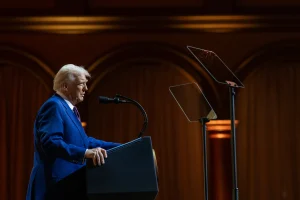The intersection of economics, environment and equity
April 20, 2022
The basic economics of the environment, such as resource management and conservation policy, have far-reaching impacts.
Polluting a waterway with carcinogenic chemicals will lead to increased health care costs for nearby residents. Declining property values can lead to a lack of external investment in a city. Destroying ecosystems in Indigenous communities can further harm already disenfranchised populations.
U.S. gross domestic product increased from $1.051 trillion in the first fiscal quarter of 1970 to $24 trillion in the fourth fiscal quarter of 2021 — the highest GDP in history. While the wealth of nations is generally increasing, the wealth gap between the economic elite and the working class is widening. According to a Pew Research study, as of 2016, upper-income families had 7.4 times as much wealth as middle-income families and 75 times as much wealth as lower-income families.
According to the Swiss Re Institute, this gap is only going to become more pronounced with climate change, which threatens to “wipe up to 18% of GDP off the worldwide economy by 2050 if global temperatures rise by 3.2°C.”
The United Nations’ High Commissioner for Refugees found that since 2010, weather emergencies and environment-related disasters have “forced more than 21.5 million people per year to move, on average” and concluded that weather-related crises have “triggered more than twice as much displacement as conflict and violence in the last decade.”
Ellen Griffith Spears is a professor in the New College and the Department of American Studies who specializes in environmental history and ethics. Her research has focused heavily on environmental justice, including the book “Baptized in PCBs,” which examines a fight for climate justice in Anniston, Alabama, a town about two hours away from Tuscaloosa.
“[Anniston] is one of two places where the Monsanto chemical company manufactured PCBs,” Spears said. “They knew from the 1930s, and the world knew beginning in 1966, that they were quite hazardous to human health, but the people who lived there did not find out about that until the 1990s.”
Aside from the numerous health impacts of PCBs, or polychlorinated biphenyls, which include impacts on the immune and reproductive systems, the long-term economic impact of contamination can be just as severe.
Spears said the Environmental Protection Agency estimates more than 45 miles of waterways south of Anniston have been contaminated by PCBs, impacting thousands of residents and habitats surrounding the area.
“Owning their own homes is, for most people, the main way of accumulating value and passing it on. So [contamination] greatly reduces home value and in some cases makes it impossible to sell,” Spears said. “But there are much larger questions, such as the tax burden of maintaining the water system. Environmental justice is deeply connected, and is not only placed in communities of color but then damages their long-term economic prospects.”
The Environmental Protection Agency defines environmental justice as “the fair treatment and meaningful involvement of all people regardless of race, color, national origin, or income, with respect to the development, implementation, and enforcement of environmental laws, regulations, and policies.”
Though her research hasn’t focused specifically on the University, Spears said she would like to see the University address its relationship to environmental justice. Spears recommended a sustainability survey to take stock of what is being done across different departments.
“One is what buildings and maintenance is doing on the recycling front. Two is what kinds of student activities exist so that people could know where to plug in. The other is the breadth of research, an overview,” Spears said.
A common argument levied against climate policies is their immediate economic impact. Critics argue that the multitrillion-dollar price tag of plans like the Green New Deal would destroy the economy and cost millions of people jobs. The Green New Deal aims to shift the United States’ economic resources into building mass sustainable infrastructure to combat climate change, including social safety nets like guaranteed housing, universal healthcare and tuition-free public education. However, research from Scientific American shows that the negative effect of inaction would be far greater in the long run.
“The kind of investment we can make now is extraordinarily cost-saving in the future,” Spears said. “Interestingly enough, it’s not just the environmental movement now that’s talking about it, but certain corporate entities have realized that switch in a very short time frame.”
The focus then becomes policy. Spears said that sometimes, it needs to start from the basics.
“I think it’s really good that The University of Alabama is focusing a lot of attention on water,” Spears said. “Food is another big area. Students have been involved in terrific ways in community gardens and supporting community-based agriculture.”
Michael Price is the Dwight Harrigan Endowed Faculty Fellow in Natural Resource Economics in the Culverhouse College of Business. As a trained behavioral economist, Price specializes in researching ways that conservation efforts can be effectively marketed and promoted to consumers.
Price said treating sustainability efforts as a competition would have economic and environmental benefits.
“I think competitions are nice on a lot of dimensions because they give potential benefits and you’re not necessarily relying just upon people’s intrinsic motivations … so you can engage a broader set of people,” Price said.
Sustainability competitions could include comparing residence halls’ energy use against one another, with the most energy-efficient residence hall winning a prize. The University used to operate an energy dashboard called the Crimson Energy Connection that “uses smart meters to track electric, natural gas, chilled water and hot water data in real time.”
From Sept. 30 to Oct. 13, 2019, Crimson Energy Connection hosted the “Battle of the Halls,” in which residence halls were pitted against one another to see who could save the most energy within the allotted time frame. The winning residence hall received a “special prize provided by the Residence Hall Association.”
In total, 890 million British thermal units and $12,142.06 were saved from the competition. Crimson Energy Connection’s website reports that the University spends over $20 million annually on energy resources.
Price said the pandemic also played a role in energy efficiency and environmental change.
“In Germany, people adopted more strategies and behaviors in the home that would save energy during the pandemic and reported that they engage in these behaviors more frequently during the pandemic than they had beforehand,” Price said. “There have been articles that have come out in Science and Nature showing that the skies over Beijing are clear and that there are reductions in air pollution. Now, part of that was an artifact of less industrial production, but if some of it is coming through the consumers, or even the businesses … people became more cognizant.”
Sustainability is about individual incentives, but it’s also about the sustainability practices of corporations, businesses and public entities like universities. From an economic perspective, it’s imperative to consider the interests of a conglomerate: money.
“What are they trying to optimize?” Price asked. “For a university, it’s attracting better students, it’s long-run engagement, it’s faculty. … Is it something that will change the demand for seats at the university? Is it something that alums or outside groups would come in, and will it be a new source of financing for them?”
Price suggested integrating environmentalism and sustainability into the undergraduate research experience.
Environmentalism encapsulates all fields of study, from economics and business to technology, engineering and design. Not only could research-driven sustainability practices improve the local and statewide environment; they could also raise the demand for a spot at the University. With more demand comes more opportunity to raise funds.
“If you can engage a large number of students in small changes, they add up, and over time, you hope that you develop habits … and you learn that change isn’t as painful as you think,” Price said.
Price said history has proven humans to be creatures of habit. Creating new and meaningful habits must begin on an individual level, because change comes in aggregate.
Sophomores Rilyn Todd, a sustainability and environmental engineering major, and Jacob Hegelson, a marine sciences and biology major, are vice president-elect and secretary-elect, respectively, of the UA Environmental Council, a campus environmental advocacy and awareness organization.
Todd and Hegelson have bold visions for what a sustainable campus could look like.
“There’s a long way to go, but [a sustainable campus] would look like net zero emissions — not meaning net zero as in the promise of net zero, where we rely on future technologies, but net zero as in we don’t produce carbon,” Todd said.
To accomplish this, Todd listed several steps the University could take, ranging from cleaner public transport, localized food systems, permaculture gardens, all the way to divesting University assets from fossil fuels and reinvesting in renewable energy initiatives.
Todd and Hegelson believe that current economic practices will ultimately fail in the face of the climate crisis but could be revitalized through innovative approaches to sustainability and equity.
“I honestly think switching to sustainable conditions would ultimately, in the much longer term, increase the stability of economics,” Hegelson said.
Todd and Hegelson have said that, for the longest time, sustainability has been interpreted as a compromise between wealth and Earth, but it doesn’t have to be this way.
“It goes back to the idea, or the fact, that our economic system doesn’t make sense for the real world, and it doesn’t apply to the planet that we live on, because it assumes that natural resources are infinite, and that’s not true,” Hegelson said. “It also makes a lot of assumptions about human nature that are also not true, so we just can’t continue with this extractive capitalist system in which we just take whatever we want.”
This story was published in the Environmental Edition. View the complete issue here.
Questions? Email the culture desk at culture@thecrimsonwhite.com.





















